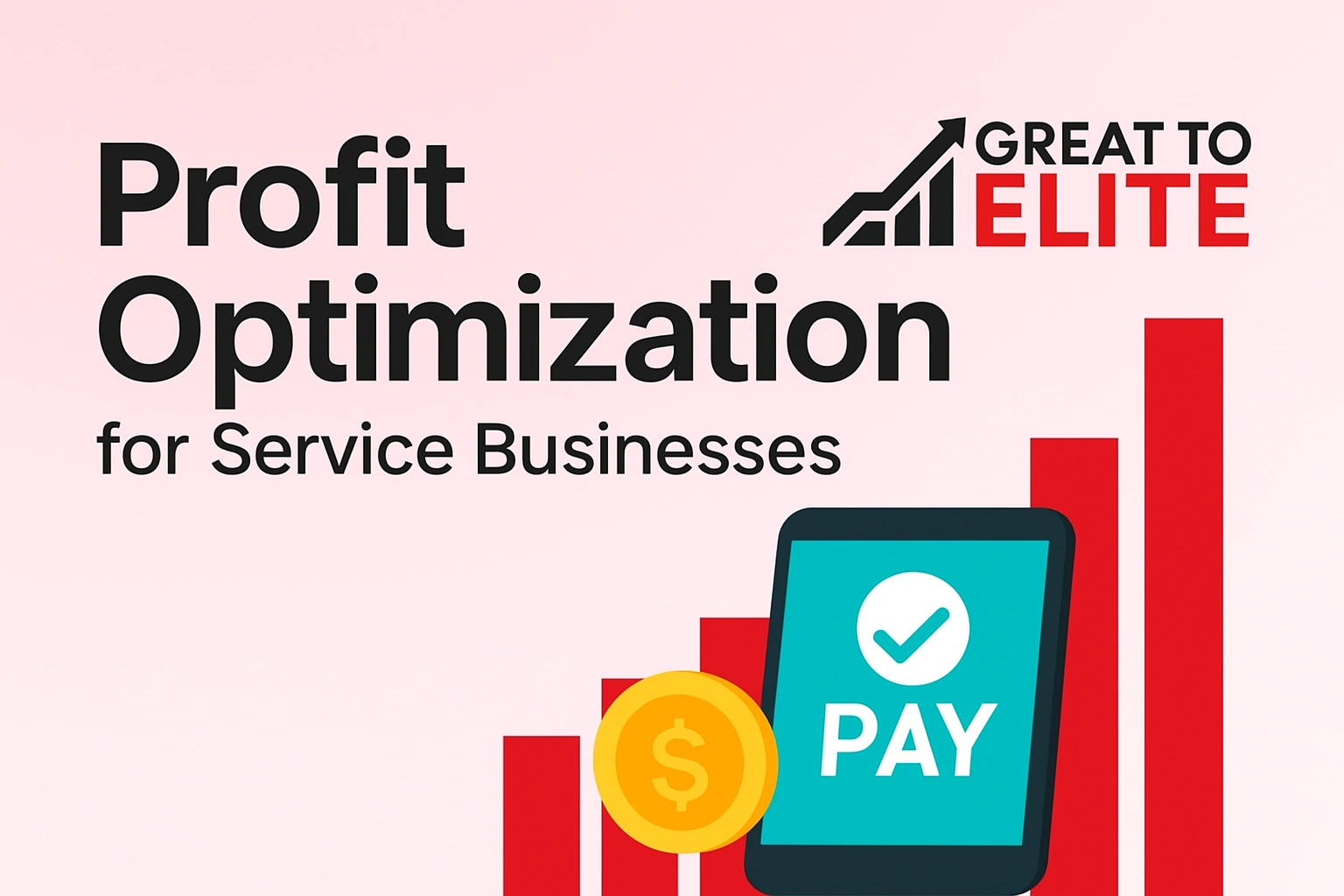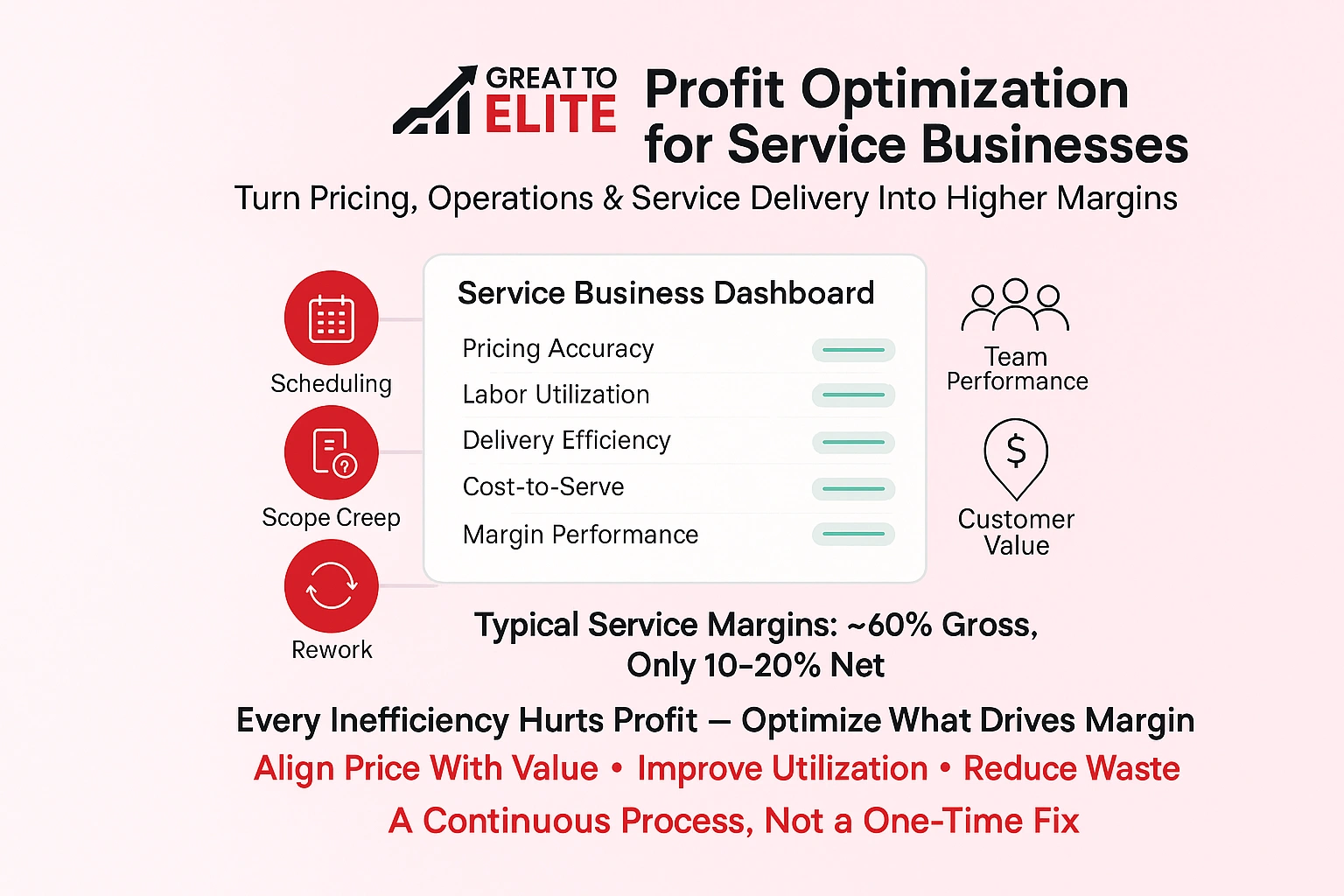Profit Optimization for Service Businesses








Profit optimization is the systematic process of identifying, measuring, and improving every factor that influences profitability, pricing, service mix, labor utilization, delivery efficiency, customer behavior, cost structure, and capacity. It’s not a single tactic. It’s a continuous discipline that ensures the work you deliver consistently produces the highest possible margin with the resources you already have.
For service businesses, profit optimization looks different than in product-based companies. You’re not managing inventory or manufacturing costs, you’re managing time, expertise, billable hours, project scopes, client expectations, and the performance of technicians or teams. Most service-provider businesses operate with around 60% gross margin and only 10–20% net margin, which means even small inefficiencies or pricing errors can significantly erode profit. Profit is won or lost in scheduling, job completion times, rework rates, scope creep, idle capacity, repeatable workflow quality, and how accurately you price services based on true cost and effort.
Today, getting margins right means matching what you charge to what customers truly value, and to what it costs you to deliver.
You align price with perceived value and actual delivery costs so each engagement supports sustainable profit without hurting the customer experience.
Key elements include:
In U.S. service businesses, fast market shifts and tight competition make timely pricing and cost decisions an advantage.
When you connect customer feedback, delivery efficiency, and market analysis, you move faster on pricing updates and protect long-term growth.
Adopt a cross-functional rhythm so finance, delivery, sales, and marketing use the same data and make coherent decisions that strengthen resilience during volatility.

First, build a simple view that ties every service to the revenue it earns and the expenses it consumes. This gives you a clear baseline to measure change and test ideas.
Construct a service-line P&L that isolates revenue, direct labor, subcontractor fees, and delivery overhead. This reveals true contribution to profit and shows where to invest or cut.
Define and track gross margin and contribution margin by service. Add CLV versus CAC, utilization, realization, and churn to quantify profitability.
Run monthly variance reviews that compare actuals to budget and trigger timely corrective decisions. Add time-phased forecasts to anticipate capacity limits and protect margins.
Use cohort analysis for CLV and payback periods to set acceptable CAC by segment. Close the loop: translate findings into staffing, pricing, and service decisions to improve long-term profitability and support ongoing optimization.
Smart pricing links what you charge to the outcomes customers care about. Value the result your service creates rather than the hours it takes. This shifts discussion from cost to customer value and frees you to capture a fair share of gains.
Value-based pricing sets fees based on perceived benefit. Use outcome metrics and case data to justify higher rates for distinct results.
Dynamic pricing adjusts ranges by demand, lead time, and capacity. Apply rules that protect margins during peaks and reward fill-in demand during slow periods.
Segment by industry, urgency, and complexity so offers match ability to pay. This reduces across-the-board discounting and improves close rates.
Test price points and packages with A/B pilots. Use win-loss feedback and objection analysis to refine floors and guardrails.
Streamlining how work flows through your teams cuts waste, saves expenses, and frees cash for profitable growth.
Map end-to-end processes to spot bottlenecks, rework, and handoff delays that inflate cost and hurt delivery. Visual maps make problems obvious and guide targeted fixes.
Standardize delivery with playbooks and checklists to improve quality, predictability, and cost efficiency. Clear steps reduce variation and help maintain consistent margins over time.
Align staffing and schedules with demand to avoid idle capacity or overtime spikes. Deploy tiered service levels so effort matches customer expectations and cost-to-serve.
Reinforce continuous improvement with frontline feedback, training, and incentives tied to productivity and profitability. Protect quality with checkpoints that reduce costly rework and safeguard your reputation.
Small operational changes free capacity and cash for higher-value work. When you link these efforts to clear metrics, you sustain growth and improve long-term profit.
Certain shifts in which products and services you sell change customer behavior and the economics of each sale. Use simple analysis to decide what to scale, rework, or retire.
Rank offerings by margins, capital intensity, and demand. Emphasize top-quartile items and set clear exit criteria for weak lines, low price, high delivery cost, or falling demand.
Bundle complementary services with a product or two to raise average order size and utilization. Test packages with pilots and track attach rates, lift in revenue, and retention.
Move specialized or volatile tasks to partners to lower delivery cost and variability. This frees your team to focus on core, higher-margin services that drive growth.

Use modern tools to turn fragmented data into fast, actionable decisions that keep your teams aligned.
Centralize data from delivery, finance, and sales so everyone uses the same source of truth. Clean data speeds your analysis and shortens the time from insight to action.
Implement BI dashboards that surface margins, utilization, and pipeline signals in near real-time. These dashboards guide daily decisions and make trends obvious.
Pilot pricing software to test elasticity and apply rules tied to demand and capacity. Link those tools to your ERP or scheduling systems to reflect real production and inventory-like constraints in services.
Apply predictive analytics to forecast service demand, staffing needs, and likely bottlenecks. Better forecasts improve scheduling and reduce last-minute overtime or missed deadlines.
Begin with a focused market scan to reveal pricing gaps and customer expectations. This lets you set clear hypotheses and avoid guesswork. Use concise research and share findings across teams so everyone understands the target.
Map competitor positioning, offers, and price bands by segment. Collect primary data from calls and bids and secondary data from public lists, reviews, and marketing channels.
Run a simple analysis comparing your service features, delivery time, and prices. Use that to define value tiers and likely willingness to pay.
Design controlled pilots with clear success metrics: profit, revenue per engagement, win rate, and retention. Run A/B tests on prices, terms, and packaging to isolate what lifts results without hurting demand.
You get a focused plan that ties pricing, processes, and people to measurable outcomes. Great to Elite works with your leadership to turn strategy into repeatable ways of working that drive faster decisions and lasting gains.
Our approach combines a clear strategy with practical tools and software so your team acts on timely data, not guesses. We align services, quality targets, and company goals to protect customers while raising margins and long-term profitability.
What to expect: faster time to decisions, higher profits, resilient profitability, and practical ways to execute with your current team and systems.
Ready to move? Book a call with Great to Elite to assess opportunities in your company and build an actionable plan tailored to your services and growth goals.

Turn data into action: structure simple routines that translate market signals into day-to-day pricing and delivery choices. This keeps your company responsive and aligned across sales, operations, and finance.
You now have a practical map that ties pricing and costs to customer value so margins and profit stay protected. Use service-line P&Ls, CLV/CAC, and short forecasts to move decisions from intuition to data.
Deploy value-based, dynamic, and segmented pricing tests. Cut expenses with standardization, outsourcing, and targeted process work. Bundle product and service offerings to raise average order value.
Leverage lightweight technology, dashboards, and regular reviews to scale wins. Keep experimenting, align teams, and turn insights into sales messaging that supports customers and sustainable growth in U.S. service businesses.